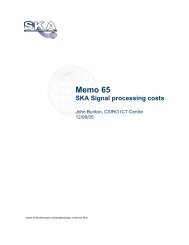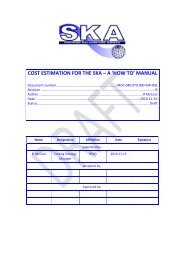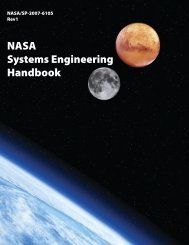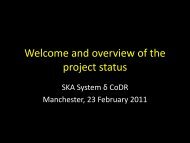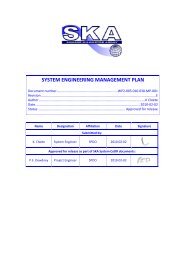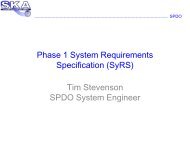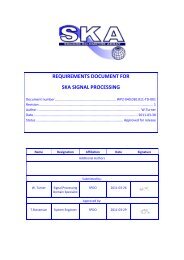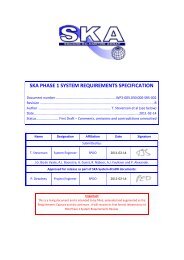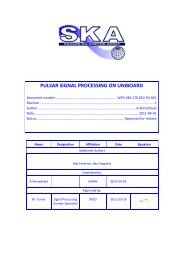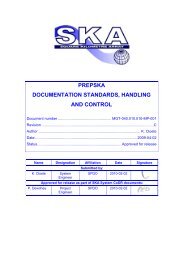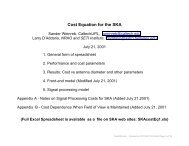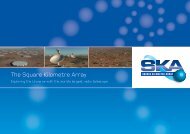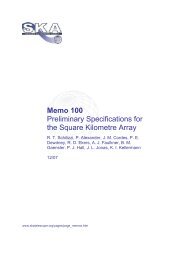document requirements descriptions - The Square Kilometre Array
document requirements descriptions - The Square Kilometre Array
document requirements descriptions - The Square Kilometre Array
You also want an ePaper? Increase the reach of your titles
YUMPU automatically turns print PDFs into web optimized ePapers that Google loves.
SKA-TEL.SE-SKO-DRD-001Revision : 1DOCUMENT HISTORYRevision Date Of Issue Engineering ChangeNumberCommentsA 2013-01-01 - First draft release for internal reviewB 2013-02-25 - Updates following reviewC 2013-02-28 - EditorialD 2013-03-07 - Editorial1 2013-03-10 - Release for RfPDOCUMENT SOFTWAREPackage Version FilenameWordprocessor MsWord Word 2007 SKA-TEL.SE-SKO-DRD-001-1_DocReqDesc.docxBlock diagramsOtherORGANISATION DETAILSName SKA OrganisationRegistered Address Jodrell Bank ObservatoryLower WithingtonMacclesfieldCheshireSK11 9DHUnited KingdomWebsiteRegistered in England & WalesCompany Number: 07881918www.skatelescope.org2013-03-10 Page 2 of 33
SKA-TEL.SE-SKO-DRD-001Revision : 1TABLE OF CONTENTS1 INTRODUCTION ............................................................................................. 51.1 Purpose of the <strong>document</strong> ....................................................................................................... 51.2 Scope of the <strong>document</strong> ........................................................................................................... 52 REFERENCES ................................................................................................ 62.1 Applicable <strong>document</strong>s............................................................................................................. 62.2 Reference <strong>document</strong>s ............................................................................................................. 63 DRDS ........................................................................................................ 93.1 PROJECT MANAGEMENT PLAN (DRD-01) ............................................................................... 93.2 PROGRESS REPORT (DRD-02)................................................................................................ 103.3 ACTION ITEM LIST (DRD-03).................................................................................................. 103.4 CONFIGURATION CONTROL PLAN (DRD-04)......................................................................... 113.5 CONFIGURATION ITEM DATA LIST (DRD-05) ........................................................................ 113.6 ANALYSIS TREE (DRD - 06) ..................................................................................................... 123.7 CHANGE REQUESTS (DRD-07) ............................................................................................... 123.8 REQUEST FOR WAIVER – RfW (DRD-08) ............................................................................... 133.9 NON-CONFORMANCE REPORT - NCR (DRD-09).................................................................... 133.10 DESIGN REVIEW DATA PACKAGE (DRD-10)........................................................................... 143.11 DESIGN REPORT (DRD-11)..................................................................................................... 143.12 ANALYSIS REPORT (DRD-12).................................................................................................. 153.13 DRAWING SETS (DRD-13)...................................................................................................... 173.14 LOWER LEVEL SPECIFICATIONS (DRD-14) ............................................................................. 173.15 MANUFACTURING PLAN (DRD-15) ....................................................................................... 173.16 ELEMENT TECHNICAL REQUIREMENTS SPECIFICATION (DRD-16) ........................................ 183.17 SOFTWARE REQUIREMENTS SPECIFICATION (DRD-16) ........................................................ 193.18 OPERATIONS MANUAL (DRD-17) .......................................................................................... 193.19 MAINTENANCE MANUAL (DRD-18) ...................................................................................... 203.20 SOFTWARE MANUAL (DRD -19)............................................................................................ 203.21 SPARE PARTS LIST (DRD-20) .................................................................................................. 213.22 PRODUCT ASSURANCE & SAFETY (DRD-21) .......................................................................... 213.22.1 Product Assurance Plan (DRD 21A) ............................................................................... 223.22.2 Product Assurance Progress Report (DRD 21B) ............................................................ 233.22.3 Safety and reliability analysis (DRD 21C) ...................................................................... 233.22.4 Reliability and Safety test procedures (DRD 21D)......................................................... 263.22.5 Other (DRD 21E) ............................................................................................................ 273.23 VERIFICATION PLAN (DRD-22)............................................................................................... 273.23.1 Assembly, integration and test plan (AITP) – DRD 22a ................................................. 273.23.2 Test specification (TSPE) – DRD22b .............................................................................. 293.24 TEST PROCEDURE (DRD-23) .................................................................................................. 303.25 TEST REPORT (DRD-24) ......................................................................................................... 313.26 ACCEPTANCE DATA PACKAGE (DRD-25) ............................................................................... 323.27 DEVELOPMENT PLAN (DRD 26) ............................................................................................. 323.28 INTERFACE CONTROL DOCUMENT (DRD-27)........................................................................ 332013-03-10 Page 3 of 33
SKA-TEL.SE-SKO-DRD-001Revision : 1LIST OF ABBREVIATIONSAN ................................. AnotherEX .................................. ExampleSKA ............................... <strong>Square</strong> <strong>Kilometre</strong> <strong>Array</strong>SKA PO ......................... Office of the SKA OrganisationTBC ............................... To be ConfirmedTBD ............................... To Be DeterminedTBS ............................... To Be Supplied2013-03-10 Page 4 of 33
SKA-TEL.SE-SKO-DRD-001Revision : 11 Introduction1.1 Purpose of the <strong>document</strong><strong>The</strong>se Document Requirement Descriptions are provided in order that technical interchangebetween SKA Element suppliers and the SKA Office is of a uniform quality and of a consistent format.1.2 Scope of the <strong>document</strong><strong>The</strong>se DRDs apply to the Pre-Construction Phase of SKA1. Applicability to Phase 2 is TBD.2013-03-10 Page 5 of 33
SKA-TEL.SE-SKO-DRD-001Revision : 12 References2.1 Applicable <strong>document</strong>s<strong>The</strong> following <strong>document</strong>s are applicable to the extent stated herein. In the event of conflict betweenthe contents of the applicable <strong>document</strong>s and this <strong>document</strong>, the applicable <strong>document</strong>s shall takeprecedence.[AD1] SKA Project Management Plan - TBS[AD2] SKA System Engineering Management Plan - SKA-TEL.SE-SKAO-MP-001[AD3] SKA Product Assurance and Safety Plan – SKA-OFF.PAQA-SKO-QP-001[AD4] SKA Glossary MGT‐040.030.015‐LST‐002 Rev L[AD5] SKA Interface Management Plan SKA-TEL.SE.IFD-SKO-PR-001[AD6] Statement of Work for the Study, Prototyping and Design of an SKA Element SKA-‐‐TEL.OFF.SOW-SKO-SOW-001[AD7] Statement of Work for the Study, Prototyping and Preliminary Design of an SKAAdvanced Instrumentation Programme Technology SKA-TEL.OFF.AIP-SKO-SOW-0012.2 Reference <strong>document</strong>sIn the event of conflict between the contents of the referenced <strong>document</strong>s and this <strong>document</strong>, this<strong>document</strong> shall take precedence.ECSS <strong>document</strong>s may be obtained from:http://www.ecss.nl/[RD1] ECSS system Glossary of terms ECSS-S-ST-00-01C 1 October 2012<strong>The</strong> following <strong>document</strong>s are useful DRDs either implicit or explicitly referred to in this<strong>document</strong>, to which further reference can be made.[RD2] Configuration management plan - ECSS-M-ST-40C Rev.1 Configuration andinformation management, Annex A 03-Mar-00[RD3] Configuration item list - ECSS-M-ST-40C Rev.1 Configuration and informationmanagement, Annex B 03-Mar-00[RD4] Configuration item data list - ECSS-M-ST-40C Rev.1 Configuration and informationmanagement, Annex C 03-Mar-00[RD5] As-built configuration list - ECSS-M-ST-40C Rev.1 Configuration and informationmanagement, Annex D 03-Mar-00[RD6] Software configuration file (SCF) - ECSS-M-ST-40C Rev.1 Configuration andinformation management, Annex E 03-Mar-00[RD7] Configuration status accounting reports - ECSS-M-ST-40C Rev.1 Configuration andinformation management, Annex F 03-Mar-00[RD8] Change request - ECSS-M-ST-40C Rev.1 Configuration and information management,Annex G 03-Mar-00[RD9] Change proposal - ECSS-M-ST-40C Rev.1 Configuration and informationmanagement, Annex H 03-Mar-00[RD10] Request for deviation - ECSS-M-ST-40C Rev.1 Configuration and informationmanagement, Annex I 03-Mar-002013-03-10 Page 6 of 33
SKA-TEL.SE-SKO-DRD-001Revision : 1[RD11] Request for waiver - ECSS-M-ST-40C Rev.1 Configuration and informationmanagement, Annex J 03-Mar-00[RD12] Cost Breakdown Structure - ECSS-M-ST-60C Cost and schedule management, AnnexA 31-Jul-08[RD13] Critical-item list - ECSS-Q-ST-10-04C Critical-item control, Annex A 31-Jul-08[RD14] Dependability plan - ECSS-Q-ST-30C Dependability, Annex C 06-Mar-09[RD15] Reliability prediction - ECSS-Q-ST-30C Dependability, Annex E 06-Mar-09[RD16] Failure Detection Identification and Recovery - ECSS-Q-ST-30C Dependability, AnnexF 06-Mar-09[RD17] Maintainability analysis - ECSS-Q-ST-30C Dependability, Annex H 06-Mar-09[RD18] Worst Case Analysis - ECSS-Q-ST-30C Dependability, Annex J 06-Mar-09[RD19] FMEA/FMECA report - ECSS-Q-ST-30-02C Failure modes, effects (and criticality)analysis (FMEA/FMECA), Annex A 06-Mar-09[RD20] FMEA worksheet - ECSS-Q-ST-30-02C Failure modes, effects (and criticality) analysis(FMEA/FMECA), Annex B 06-Mar-09[RD21] FMECA worksheet - ECSS-Q-ST-30-02C Failure modes, effects (and criticality) analysis(FMEA/FMECA), Annex C 06-Mar-09[RD22] Customer <strong>requirements</strong> <strong>document</strong> (CRD) - ECSS-E-ST-70C Ground systems andoperations, Annex A 31-Jul-08[RD23] Nonconformance Report - ECSS-Q-ST-10-09C Nonconformance control system,Annex A 15-Nov-08[RD24] NCR Status List - ECSS-Q-ST-10-09C Nonconformance control system, Annex B 15-Nov-08[RD25] Review procedure - ECSS-M-ST-10-01C Organization and conduct of reviews, AnnexA 15-Nov-08[RD26] Review item discrepancy (RID) - ECSS-M-ST-10-01C Organization and conduct ofreviews, Annex B 15-Nov-08[RD27] Review team report - ECSS-M-ST-10-01C Organization and conduct of reviews,Annex C 15-Nov-08[RD28] Review authority report - ECSS-M-ST-10-01C Organization and conduct of reviews,Annex D 15-Nov-08[RD29] Product Assurance Plan (PAP) - ECSS-Q-ST-10C Product assurance management,Annex A 15-Nov-08[RD30] Project management plan (PMP) - ECSS-M-ST-10C Rev.1 Project planning andimplementation, Annex A 03-Mar-09[RD31] Product tree - ECSS-M-ST-10C Rev.1 Project planning and implementation, Annex B03-Mar-09[RD32] Work breakdown structure (WBS) - ECSS-M-ST-10C Rev.1 Project planning andimplementation, Annex C 03-Mar-09[RD33] Work package (WP) description - ECSS-M-ST-10C Rev.1 Project planning andimplementation, Annex D 03-Mar-09[RD34] Progress report - ECSS-M-ST-10C Rev.1 Project planning and implementation, AnnexE 03-Mar-09[RD35] QA plan - ECSS-Q-ST-20C Quality assurance, Annex A 15-Nov-08[RD36] End item data package (EIDP) - ECSS-Q-ST-20C Quality assurance, Annex B 15-Nov-08[RD37] Certificate of conformity (CoC) - ECSS-Q-ST-20C Quality assurance, Annex D 15-Nov-08[RD38] Safety analysis report including hazard reports - ECSS-Q-ST-40C Safety, Annex D 06-Mar-09[RD39] Software system specification (SSS) - ECSS-E-ST-40C Software, Annex B 06-Mar-092013-03-10 Page 7 of 33
SKA-TEL.SE-SKO-DRD-001Revision : 1[RD40] Software interface <strong>requirements</strong> <strong>document</strong> (IRD) - ECSS-E-ST-40C Software, Annex C06-Mar-09[RD41] Software <strong>requirements</strong> specification (SRS) - ECSS-E-ST-40C Software, Annex D 06-Mar-09[RD42] Interface Control Document (ICD) - ECSS-E-ST-40C Software, Annex E 06-Mar-09[RD43] Software design <strong>document</strong> (SDD) - ECSS-E-ST-40C Software, Annex F 06-Mar-09[RD44] Software release <strong>document</strong> (SRelD) - ECSS-E-ST-40C Software, Annex G 06-Mar-09[RD45] Software User Manual (SUM) - ECSS-E-ST-40C Software, Annex H 06-Mar-09[RD46] Software verification plan (SVerP) - ECSS-E-ST-40C Software, Annex I 06-Mar-09[RD47] Software validation plan (SValP) - ECSS-E-ST-40C Software, Annex J 06-Mar-09[RD48] Software [unit/integration] test plan (SUITP) - ECSS-E-ST-40C Software, Annex K 06-Mar-09[RD49] Software validation specification (SVS) - ECSS-E-ST-40C Software, Annex L 06-Mar-09[RD50] Software verification report (SVR) - ECSS-E-ST-40C Software, Annex M 06-Mar-09[RD51] Software reuse file (SRF) - ECSS-E-ST-40C Software, Annex N 06-Mar-09[RD52] Software development plan (SDP) - ECSS-E-ST-40C Software, Annex O 06-Mar-09[RD53] Software review plan (SRevP) - ECSS-E-ST-40C Software, Annex P 06-Mar-09[RD54] Software product assurance plan (SPAP) - ECSS-Q-ST-80C Software productassurance, Annex B 06-Mar-09[RD55] Software product assurance milestone report (SPAMR) - ECSS-Q-ST-80C Softwareproduct assurance, Annex C 06-Mar-09[RD56] System engineering plan (SEP) - ECSS-E-ST-10C System engineering general<strong>requirements</strong>, Annex D 06-Mar-09[RD57] Design definition file (DDF) - ECSS-E-ST-10C System engineering general<strong>requirements</strong>, Annex G 06-Mar-09[RD58] Specification tree - ECSS-E-ST-10C System engineering general <strong>requirements</strong>, AnnexJ 06-Mar-09[RD59] Design justification file (DJF) - ECSS-E-ST-10C System engineering general<strong>requirements</strong>, Annex K 06-Mar-09[RD60] Interface requirement <strong>document</strong> (IRD) - ECSS-E-ST-10C System engineering general<strong>requirements</strong>, Annex M 06-Mar-09[RD61] Requirements traceability matrix (RTM) - ECSS-E-ST-10C System engineering general<strong>requirements</strong>, Annex N 06-Mar-09[RD62] Requirements justification file (RJF) - ECSS-E-ST-10C System engineering general<strong>requirements</strong>, Annex O 06-Mar-09[RD63] Product user manual (PUM or UM) - ECSS-E-ST-10C System engineering general<strong>requirements</strong>, Annex P 06-Mar-09[RD64] Analysis report - ECSS-E-ST-10C System engineering general <strong>requirements</strong>, Annex Q06-Mar-09[RD65] Technical <strong>requirements</strong> specification (TS) - ECSS-E-ST-10-06C Technical<strong>requirements</strong> specification, Annex A 06-Mar-09[RD66] Assembly, integration and test plan (AITP) - ECSS-E-ST-10-03C Testing, Annex A 01-Jun-12[RD67] Verification plan (VP) - ECSS-E-ST-10-02C Verification, Annex A 06-Mar-09[RD68] Verification control <strong>document</strong> (VCD) - ECSS-E-ST-10-02C Verification, Annex B 06-Mar-092013-03-10 Page 8 of 33
SKA-TEL.SE-SKO-DRD-001Revision : 13 DRDs3.1 PROJECT MANAGEMENT PLAN (DRD-01)<strong>The</strong> Project Management Plan (PMP) shall describe, as a minimum, the following aspects:<strong>The</strong> project strategy and approach<strong>The</strong> management approach implemented by the Contractor to manage and control theproject.<strong>The</strong> organisational structure and governance of the project<strong>The</strong> roles, responsibilities and the authority of each function in the organisational structureincluding job <strong>descriptions</strong> for key functions<strong>The</strong> interrelation among the different functions in the organisation.Description of where and how the management and control of the lower tier Contractors isestablished in the project organisation.<strong>The</strong> structure for the Project Management Plan is:Section 1Addressing the purpose; structure; validity and applicability of the <strong>document</strong>.Section 2 Provide an overview of the project in terms of the project objectives; scope; projectstrategies; project phases and current status of the project.Section 3 Provide an overview of the project organisation and governance including how theproject is structured in terms of the project levels, project role-players and stakeholders,organisational structures and roles and responsibilities within these structures. In case of aconsortium the overview will include a comprehensive description of all these aspects in relation tothe members of the consortium.Section 4 Provide a description of the project management aspects of the project includinghow the project will be managed in terms of the scope (work), time schedule, cost (resources);progress reporting; decision making; communication and project management tools.Section 5 Provide a description of the project implementation and execution addressing howthe implementation of the project will be managed in terms of engineering, procurement,construction, commissioning and handover to operations.Section 6Section 7Provide a description on how risk will be managed.Provide a description on how product assurance and quality will be managed.Section 8 Provide a description on how configuration of the product and change control(including project and technical) will be managed.Section 9Provide a description on how information and <strong>document</strong>ation will be managed.Section 10 Provide a description on how safety, occupational health and environmental aspectswill be managed.Section 11Provide a description on how human resources for the project will be managed.2013-03-10 Page 9 of 33
SKA-TEL.SE-SKO-DRD-001Revision : 1Section 12Section 13Section 14Provide a description on how the participation of industry will be managed.Provide a description on how outreach (public relations) will be managed.A list of applicable and reference <strong>document</strong>s used to compile the PMP.3.2 PROGRESS REPORT (DRD-02)<strong>The</strong> Progress Report summarises the progress of the project on a periodic basis.It shall summarise the achievements of the period at all levels of the project and show them againstthe planned date contained in the Project Schedule putting in evidence any deviations description ofcritical schedule and technical issues utilised in the reporting period and anticipated for the future.It shall discuss every problem detected at any level of the project during the reporting period andshall address the planned remedial activities.Progress reports are delivered on a quarterly basis or more often if needed. <strong>The</strong>y shall be providedto SKA PO not later than the 10th of the following month.Furthermore the progress report shall include:Schedule reporting and updating which reflects the updated schedule versus baseline planning,reassessment of all start and completion dates for all activities:* Action item list* Status of critical item list* Inspection Planning* Supplier selection and qualification* Status list and classification of NCRs* Status list of requests for waiver.* Status list of ECPs* Overview of major events in the forthcoming period* PA/QA reports of MIPs, test reports, audits* Current PA/QA activities* Current problems and status of related actions* Status of Configuration Item List (CIDL)3.3 ACTION ITEM LIST (DRD-03)It shall list all the actions agreed between the Contractor and SKA PO* <strong>The</strong> subject of the action:* <strong>The</strong> originator:* <strong>The</strong> actionee(s);* <strong>The</strong> due date and the closure date:* <strong>The</strong> reference to the <strong>document</strong>(s) containing the basis for the closure of the action.This list will be reviewed at each progress meeting2013-03-10 Page 10 of 33
SKA-TEL.SE-SKO-DRD-001Revision : 13.4 CONFIGURATION CONTROL PLAN (DRD-04)<strong>The</strong> Contractor shall submit for approval a Configuration Control Plan which shall describe theproject configuration control organisation, methods, tools and procedures the Contractor intends toimplement for the work under Contract. <strong>The</strong> Configuration Control Plan shall define:* <strong>The</strong> handling of contractual changes:* <strong>The</strong> handling of the interfaces internal to the project;* <strong>The</strong> handling of the interfaces external to the project:* <strong>The</strong> handling of technical changes.<strong>The</strong> Configuration Control System to be implemented on the basis of the approved ConfigurationControl Plan shall ensure that:* <strong>The</strong> manufacturing <strong>document</strong>ation is in line with the design <strong>document</strong>ation:* <strong>The</strong> product is in line with the manufacturing <strong>document</strong>ation;* Changes are not implemented without due analysis and approval:* Required Configuration Item and/or manufacturing changes are properly <strong>document</strong>ed inChange Requests to be established by the Contractor* Requests for Waivers/ Non-Conformance-Reports are properly handled.<strong>The</strong> Configuration Control Plan and System shall be imposed on all sub-contractors and third partiesparticipating in the execution of the Contract.<strong>The</strong> Configuration Control implies the establishment of a Configuration Item Data List, whichincludes lists of valid specifications, drawings and in general all <strong>document</strong>ation items properly datedand numbered for each configuration item.3.5 CONFIGURATION ITEM DATA LIST (DRD-05)<strong>The</strong> CIDL is the list containing all <strong>document</strong>s which define the SKA. Except for the Interface ControlDrawings, drawings shall not be entered individually into the CIDL; only the drawing list. <strong>The</strong> CIDLplays a crucial role in the verification and acceptance tests and reviews.<strong>The</strong> CIDL shall list all valid and released SKA <strong>document</strong>s from the following categories:1. Requirementsa. Top Level Requirements Documentsb. Requirement Specification / Design Specification on item levelc. Requirement Specification / Procurement Specification on lower leveld. Identification of Deviations2. Definition of the hardware and software (WBS, Drawing List / Tree, etc.)3. Analysis Documentationa. Feasibility analysesb. Safety and hazard analyses4. Design Documentation (design reports, circuit diagrams, technical notes, etc)2013-03-10 Page 11 of 33
SKA-TEL.SE-SKO-DRD-001Revision : 15. Interface Control Documentationa. ICDsb. Interface control drawingsc. Grounding diagramsd. Others as needed6. Listsa. Parts, material and component listb. Process listc. Change status list7. As Built Configuration Lista. Manufacturing drawing files listb. NCR status listc. RfW status listd. ECP status liste. List of lower level ADPs (acceptance data packages)8. Documentation list for assembly, integration, test and calibration, verificationa. Procedures and test plansb. Reportsc. Verification Matrixd. Log Bookse. Cleanliness record9. Manuals and Handling Proceduresa. Project Management Planb. PA manualc. User manual10. Open Work3.6 ANALYSIS TREE (DRD - 06)<strong>The</strong> analysis tree describes the hierarchical order and the logic of the various analyses to beperformed during the design and development phase.This shall include evaluation tests of components, bread boarding activities, demonstration modelsetc.It shall show in the form of a flow chart all the analysis and assessments foreseen.3.7 CHANGE REQUESTS (DRD-07)It describes the initiated change requests. It shall contain:2013-03-10 Page 12 of 33
SKA-TEL.SE-SKO-DRD-001Revision : 1* Identification of the Work Package;* <strong>The</strong> description and justification of the change requested;* <strong>The</strong> reasons for the change request;* An assessment of the impact of the change on the programmatic, costs, functional andperformance <strong>requirements</strong> of the project at any level.More details are given in the SKA Change Request Procedure SKA-TEL.SE.CDM-SKO-PR-0013.8 REQUEST FOR WAIVER – RfW (DRD-08)A Request for Waiver is usually issued during the manufacturing, test and integration, and is issuedby the SKA PO for a single deliverable item.A Non-Conformance Report shall be the basis of any Waiver.a) A relief from the relevant specification, test procedure, integration <strong>requirements</strong> and/orb) To grant acceptance from SKA to use different hardware items or materials due to theinability to procure the specified ones in due time to meet the time schedule.A granted waiver does not lead to changes of any approved and released <strong>document</strong>.<strong>The</strong> Request for Waiver shall include:* Definition of the item affected* Identification of <strong>document</strong>s, software and hardware affected* Description of the waiver* Description of the need for the waiver including references to the associated NCR(s)* Effects on costs and schedule.It shall be accompanied by all <strong>document</strong>ation required by SKA PO to judge the acceptability of thewaiver.If any changes in planned costs, schedule or performance are expected, these points shall be clearlyaddressed.(Note: It is recalled that SKA PO has no obligation to accept a request for waiver; SKA PO willhowever provide a reply to this request within 4 weeks).*If all SKA deliverable items are concerned a Change Request has to be issued.3.9 NON-CONFORMANCE REPORT - NCR (DRD-09)It shall report non-conformities which occurred during the manufacture, assembly, testing at alllevels of the project and which are authorized by SKA PO. <strong>The</strong> NCR forms are part of the "as built"drawing set.<strong>The</strong> report shall show the following information:* Reference number of the non-conformance* Staff member who has identified the non-conformance2013-03-10 Page 13 of 33
* Where has the non-conformance occurred* date of the observation* description of the non-conformance and the reference to the specification* disposition of the Material Review Board (MRB)Dispositions could be:• “ scrap”• “Use as is” (waiver - only for “major”)• “Rework” (original process)• “Repair” ( standard or non-standard methods to be defined)• “Change / modify the design”: (Change Request)• “Back to manufacturer/dealer”* cause of the non-conformance* corrective action proposalMore details are given in SKA product assurance <strong>document</strong>s.3.10 DESIGN REVIEW DATA PACKAGE (DRD-10)SKA-TEL.SE-SKO-DRD-001Revision : 13.11 <strong>The</strong> design review data package is a collection of all <strong>document</strong>ation whichallows scrutinising the compatibility of the design with the specified<strong>requirements</strong>. <strong>The</strong> detail of information contained in a specific data packagedepends on the project phase and thereby on the type of design review forwhich the data package will be prepared/collected. <strong>The</strong> contents of the PDRand CDR Design Review Data Packages are defined in [AD6] and [AD7].DESIGNREPORT (DRD-11)<strong>The</strong> Design Report summarises all the design features of all contract items subject of this contract.<strong>The</strong> Design Report shall address every requirement specified in the technical specifications and asapplicable to the item subject of the Design Report. In particular the Design Report shall contain thefollowing information:1. Scope of the designIn this section a general description of the contents of the Design Report shall be given.2. Applicable <strong>document</strong>sIn this section all the <strong>document</strong>s referred to in the Design Report shall be listed.3. AssumptionsAll the assumptions used in the design shall be listed. In particular:* design constraints* environmental conditions others than specified in technical specifications2013-03-10 Page 14 of 33
SKA-TEL.SE-SKO-DRD-001Revision : 1* all analysis & calculation methods (if applicable)* maintenance constraints (if applicable)* access constraints (if applicable)*(All values used in the assumptions shall be referenced).4. MaterialsAll the materials used in the design and their physical and mechanical properties as well as theirchemical behaviour shall be given. All applicable treatments and their purposes shall be described.5. Design descriptionIn this section a complete description of the design shall be given. Every requirement specified in thetechnical specifications shall be addressed. Figures and sketches shall have a caption and shall bereferenced and described in the text. For every design solution supported by calculations referenceto section 6 or to an Analysis Report shall be made.6. CalculationsIn this section all the calculations supporting the design, others than those included in the AnalysesReport shall be given in detail, including a discussion of the results.7. ConclusionsIn this section a statement concerning the compliance of the design with the <strong>requirements</strong> shall begiven. Non-conformities shall be discussed.3.12 ANALYSIS REPORT (DRD-12)<strong>The</strong> Analysis Report summarizes all the calculations which support the design (e.g. F.E. calculations.etc.).<strong>The</strong> Analysis Report shall identify which issue of the specification and which design/manufacturingconfiguration has been used for the analysis.An Analysis Report shall be produced every time if a verification by analysis is required in theverification matrix.<strong>The</strong> Analysis Report shall contain the following information:1. Scope of the analysisIn this section the purpose of the analysis shall be given as well as a general description of thecontents of the Analysis Report.2. Applicable <strong>document</strong>sIn this section all the <strong>document</strong>s referred to in the Analysis Report shall be listed.2013-03-10 Page 15 of 33
SKA-TEL.SE-SKO-DRD-001Revision : 13. AssumptionsIn this section all the assumptions used in the analysis shall be listed and discussed. In particular:* assumptions used in the definition of the model* assumptions used in defining the boundary conditions (if applicable)* assumptions used in defining the material properties (if applicable)* assumptions used in defining loads and loading cases (if applicable)* assumptions used in processing the results, (if applicable)* analysis methods4. ModelIn this section the model used in the analysis shall be described in detail.For example for a structural analysis:* the geometry* the sectional properties (if applicable)* boundary conditions* loads topology* type of elements used (if applicable)* type of component') used (if applicable)* correspondence between the model and the actual modelled componentPlots and sketches illustrating the model shall be included and shall be readable in all details. <strong>The</strong>detail of the description shall allow reproducing the model.5. Loading cases (for structural analyses)In this section the loading cases shall be identified.<strong>The</strong> loading applied to the model shall be given and illustrated in plots and/or sketches. A list of theloaded nodes shall be given (if applicable).6. ResultsIn this section the result" shall be summarized and discussed.<strong>The</strong> results coming out from the analysis shall be processed in such a way that they are directlycomparable with the verification items verified. A comparison table shall summarize the calculatedvalues with the values of the verification items.7. ConclusionsIn this section a statement concerning the compliance of the results with the performance<strong>requirements</strong> shall be given. Non-Conformities shall be discussed.2013-03-10 Page 16 of 33
SKA-TEL.SE-SKO-DRD-001Revision : 13.13 DRAWING SETS (DRD-13)<strong>The</strong>y shall define at all levels of the project the as-designed and as-built product.Drawing sets shall be prepared in accordance with DIN standards or equivalent and approved by SKAPO and shall contain all information necessary to manufacture, assembly, and test the item and thenecessary support equipment.3.14 LOWER LEVEL SPECIFICATIONS (DRD-14)<strong>The</strong>y are the specifications, at all levels of the project, which define the sub-assemblies and whichshall be prepared by the Contractor or/and by the sub-contractors.<strong>The</strong> specifications shall contain at a minimum:Applicable <strong>document</strong>sItem descriptionInterface definitions, <strong>requirements</strong>Performance characteristics <strong>requirements</strong>Physical characteristics:RAMS <strong>requirements</strong>Environmental conditions including EMC, cleanliness etc.Design and construction <strong>requirements</strong> (parts, materials. processes, components, workmanship etc.)Assembly <strong>requirements</strong>Transport <strong>requirements</strong>Documentation <strong>requirements</strong>Personnel and trainingQuality assurance and managementConfiguration control and managementVerification <strong>requirements</strong>:• Test• Analyses• Similarity (verified already in another project with similar conditions)• Qualification procedure• Design review• Audit• Inspection• Certificate3.15 MANUFACTURING PLAN (DRD-15)<strong>The</strong> manufacturing plan shall list all actions which are planned for the manufacture, inspection,testing and transport of the units to the destination.<strong>The</strong> plan shall include a PERT diagram of all activities with the foreseen duration and shall referenceall relevant <strong>document</strong>s (drawings, procedures, etc.).Constraints on procurement or deliveries will be identified.2013-03-10 Page 17 of 33
3.16 ELEMENT TECHNICAL REQUIREMENTS SPECIFICATION (DRD-16)SKA-TEL.SE-SKO-DRD-001Revision : 1Introduction<strong>The</strong> TRS shall contain a description of the purpose, objective, content and the reason prompting itspreparation.Applicable and reference <strong>document</strong>s<strong>The</strong> TRS shall list the applicable and reference <strong>document</strong>s in support of the generation of the<strong>document</strong>.User need presentation<strong>The</strong> TRS shall present the main elements that characterize the user’s need for developing theproduct as a background for those <strong>requirements</strong> that are defined in detail in the dedicated section.<strong>The</strong> TRS shall put the product into perspective with other related products.If the product is independent and totally self-contained, i.e. able to match the final user’s need, itshould be so stated here.If the TRS defines a product that is a component of a higher tier system, the TRS shall recall therelated needs of that larger system and shall describe the identified interfaces between that systemand the product.A nonexhaustive checklist of general questions that should be answered at the early stages of theTRS is:What is the product supposed to do? It is fundamental but critically important to make surethat every actor has a complete understanding of what the product has to do.Who is going to use this product? It is important to indicate who is going to use the product,why they are going to use it and for what it is going to be used.Selected concept / product presentation<strong>The</strong> technical specification shall describe the concept, the expected product architecture and thefunctioning principles on which it is based.Life cycle description<strong>The</strong> TRS shall list and describe the different chronological situations of the product’s life profile.An identifier can be associated with each situation in order to be able to link each requirement to atleast one situation in which it applies. Such an approach enables sorting and filtering of the<strong>requirements</strong> per situation.Environment and constraints description<strong>The</strong> TRS shall describe the different environments and constraints for each situation in the life profilethat the product is expected to encounter.2013-03-10 Page 18 of 33
SKA-TEL.SE-SKO-DRD-001Revision : 1An identifier can be associated with each product environment in order to be able to link eachrequirement to at least the worst environment to which it applies. Such an approach enables sortingand filtering the <strong>requirements</strong> per environment.Requirements<strong>The</strong> TRS shall list all the technical <strong>requirements</strong> necessary for the product to satisfy the user’s needs.Interfaces <strong>requirements</strong> can be rolled-out of the TRS in form an interface requirement <strong>document</strong>(IRD).For all TRS and for each requirement, the following characteristics have been selected:identifiability;performance and methods used to determine it;configuration management;traceability;toleranceverification3.17 SOFTWARE REQUIREMENTS SPECIFICATION (DRD-16)* <strong>The</strong> software <strong>requirements</strong> specification to be delivered by the Contractor shall be derivedfrom the technical specification and from further discussions with SKA-PO.* <strong>The</strong> software <strong>requirements</strong> specification should elaborate the functional and performance<strong>requirements</strong>, the normal and abnormal conditions behavior and should also include test andmaintenance <strong>requirements</strong>.* Requirements should be listed for the software, categorized in groups and listed in such away that they can be traced in the course of the development.3.18 OPERATIONS MANUAL (DRD-17)<strong>The</strong> Operations Manual describes in detail all the procedures needed to operate correctly and safely.It shall at least:* Describe the start-up procedures;* Describe the shut-down procedures;* Describe all the procedures to operate the sub-systems:* Describe all the operational error messages for the control computer and the resultingremedial action* Describe all the safety procedures to operate the unit:* List all the operational limits of the unit:* List the emergency cases which can occur during operations;* Describe emergency procedures;* Make reference to any other procedure needed for safe and correct operation;* Trouble-shooting;2013-03-10 Page 19 of 33
SKA-TEL.SE-SKO-DRD-001Revision : 13.19 MAINTENANCE MANUAL (DRD-18)<strong>The</strong> maintenance manual shall contain the results of a maintainability analyses and detailedmaintenance procedures with drawings. It shall contain the maintenance <strong>requirements</strong> andscheduling for all items included in the supplies of a contract. Beside the description of themaintenance actions, including the necessary procedure and recommendations for an assembly anddisassembly. it shall provide a maintenance check-list or matrix including information about:* Item to be maintained:* Reference to maintenance manuals;* Type of maintenance, inspection etc.;* Dates (intervals) for maintenance:* Duration of maintenance action:* Effect on other systems, functions of the Unit;* Required parts and consumables and tools:* Required major equipment;* Required personnel:* Estimated man-hours and skill level required for each maintenance task.A maintenance manual and a computer readable list of maintenance actions shall also be delivered,to be used later for the implementation into a centralized preventive maintenance software for thewhole SKA system. <strong>The</strong> list format will be specified by SKA PO.<strong>The</strong> Control software maintenance manual shall cover:* <strong>The</strong> internal organization of the software;* <strong>The</strong> installation procedure including the environment set-up (operating system, etc.);* <strong>The</strong> preventative maintenance operations (file clean-up, etc.).3.20 SOFTWARE MANUAL (DRD -19)It describes the software developed or expressly adapted for SKA needs.It shall:Document analysis and design, using the approved analysis and design methodology. asdefined in the SKA Software Management Plan;Document the programming language. the operating system and development system used;Document the procedures to test the conformity to the specificationsContain the design <strong>document</strong>ationDescribe the detailed procedure to install new releases and to check the installed versions.Off-<strong>The</strong>-Shelf Software ManualIn the case of any other "off-the shelf' software, the Contractor shall provide the original<strong>document</strong>ation (English version only) and a dedicated section of the software manual which:* Shall describe the function and the usage of the software2013-03-10 Page 20 of 33
SKA-TEL.SE-SKO-DRD-001Revision : 1* Shall describe off-the-shelf embedded software* Shall <strong>document</strong> in a complete way the software* Shall define the parameters necessary to customize this software* Shall <strong>document</strong> the detailed procedure to implement upgrades* Shall identify the software version3.21 SPARE PARTS LIST (DRD-20)This Spare Parts List shall contain all the relevant information concerning the required spare partssuch as:* Number quantity* Make* Addresses of manufacturers or representations* Name* Type designation* Dimensions* Specifications etc.* Delivery times* Expected lifetime* Storage conditionsIn the Spare Part List a subdivision shall be made with the following categories:Consumables* Fragile and/or critical parts* Components or parts with very long delivery time or which are custom-made* Off-the-shelf / custom-made products3.22 PRODUCT ASSURANCE & SAFETY (DRD-21)Summary<strong>The</strong> PA Plan shall describe the Contractor's general Product Assurance philosophy (QA, CM, RAMSand SWPA) and define in detail all project-specific PA related tasks, procedures, tools, etc., forsystem down to at least assembly level, as well as the organizational structure which will beimplemented to ensure that all PA- <strong>requirements</strong> are met throughout the complete project cycle.<strong>The</strong> PAP shall cover all aspects of DIN-EN-ISO 9001: 2000 and potentially applicable ECSS – Standardsor equivalent regulations and shall contain the following main chapters:1. Scope of the PAP2. Applicable Documents (product assurance manual, SOW et al.)3. General PA Approach i.e. how and when is PA involved in the individual project phase. Who isresponsible for the quality of the product, relationship between PA and project management4. Organization, Responsibilities, Resources2013-03-10 Page 21 of 33
SKA-TEL.SE-SKO-DRD-001Revision : 15. Applicable existing Procedures. Tools, Facilities6. Task Definitions* PA Management* QA Engineering* RAMS Engineering* Configuration Control* SWPA3.22.1 Product Assurance Plan (DRD 21A)Purpose: Describe the Product Assurance organisation of the contractor and the rules to beapplied to verify the implementation of the PA <strong>requirements</strong>Approval:Delivery:By SKA OfficeIn the proposal and for release before contractContent:<strong>The</strong> PA plans shall contain as a minimum:1) Description of the internal industrial organisation and PA organisation relevant tothe development programme. Organization charts, including staff and line relationships.2) Methods foreseen to ensure compliance to the SOW, during all the phases of theprogramme taking into account internal activity and subcontracting.3) Means set-up to meet those objectives (personnel/qualifications, equipment,computing, data bases).4) Definition and description of PA activities to be performed at each phase of the projectschedule. For each activity include: identification of inputs, supply of inputs, nature and sequence oftasks, expected outputs. Make at least the following chapters:RAMS,Quality AssuranceConfiguration ManagementSoftware PA5) Training programme if necessary.6) Definition and description of means for quality control.7) Definition and description of methods and tools for traceability during all phases of theprogramme.8) Definition and description of non-conformance management.9) Supplier evaluation programme.2013-03-10 Page 22 of 33
SKA-TEL.SE-SKO-DRD-001Revision : 110) Description of interfaces with other plans, especially with overall management plan,configuration management plan, coordination plan for technical activities.11) Detailed list of contractual PA <strong>document</strong>ation to be included in the offer.12) List of used materials, mechanical parts, electronic components and processes.3.22.2 Product Assurance Progress Report (DRD 21B)Purpose:To describe periodically progress of activities and status of items of concernrelative to product assuranceApproval:Delivery:By Contractor's Project Manager and PA/QA ManagerQuarterlyContent:<strong>The</strong> supplier shall report on the status and progress of the product assurance programimplementation.<strong>The</strong> PA report shall include at least the following items for the reporting period:⎯ Progress and accomplishment of each major product assurance task including resolved and newproblems, future planning of major activities and events⎯ Status of PA reviews, Audits and MIPs, Waiver requests, Non conformances (minor and major),Critical items (including mitigation action plan status), Qualification status, EEE component status,Material and processes status, Alerts status.<strong>The</strong> PA progress report may be part of the project progress report.3.22.3 Safety and reliability analysis (DRD 21C)Purpose Identify and evaluate the risks related to safety and reliability aspects insupport to the design, integration, test and operations phases.Approval:Delivery:By Contractor's Project ManagerAt design review and following a Critical Item List (CIL) six monthly reviewContent:This <strong>document</strong> is constituted of five chapters:1 - Functional Failure Analysis2 - FMECA3 - Fault Tree Analysis Report2013-03-10 Page 23 of 33
SKA-TEL.SE-SKO-DRD-001Revision : 14 - Design Hazard Analysis Report.5 - Operating Hazard Analysis ReportSummary of content / preparation information:1 -Functional Failure Analysis- Function of the item shall be listed, and. for each function shall be described all scenarioswhich can lead to Major, Serious or Catastrophic impact.This <strong>document</strong> shall give the following:- <strong>The</strong> list of considered functions, their associated criticality and the failure condition createdby the failure of the function.- For each function, the list of functional failures considered.- For each functional failure, the description of all scenarios which can lead to Major,Hazardous or Catastrophic impacts.- For each scenario:. Scenario description. Operational phase affected. Repercussion classification. Number of independent event in scenario. Concerned failure condition reference. Associated parameters: procedure, test, studies...- For each failure condition associated to functional failure analysis:. A detailed description of the impacts. A dependence diagram. <strong>The</strong> associated expected occurrence probability. <strong>The</strong> associated Critical Items. <strong>The</strong> associated maintenance tasks and periodicities. <strong>The</strong> associated parameters: tests, studies, procedures, design recommendations,2 - FMECA<strong>The</strong> <strong>document</strong> shall have the minimum following content:1) Introduction: scope, purpose qualitative and quantitative objectives.2) Related <strong>document</strong>s: applicable <strong>document</strong>s, reference <strong>document</strong>s, relations with other PA<strong>document</strong>s.3) Identification of elements, subsystems, equipment, software, interfaces, procedures,functions under considerations.4) Identification of phase, sub-phases, scenarios, undesired events, operational mode underconsideration.5) Identify applicable block diagrams. <strong>The</strong> block diagrams used for FMECA shall be consistentwith those used for reliability assessment reports.2013-03-10 Page 24 of 33
SKA-TEL.SE-SKO-DRD-001Revision : 16) Elaborate the FMECA structured using block diagrams. Effects shall be tracked at thetopmost level. Effects that can propagate across the interface of combined elements shall beidentified. FMECA at the upper level shall be based on lower level FMECAs when available.7) Identify:. safety critical and mission critical single point failure. fault identification, isolation and recovery capability need. failure tolerance requirement non compliance. reconfiguration capabilities need. critical items. safety related functions, constituents or procedures8) Propose corrective actions on design, maintenance, detection or reconfiguration capabilitiesFMECA will be conducted in accordance with:. MIL STD 1629 A. or other normalization <strong>document</strong> approved by the SKA Office (e.g. ECSS or others)For each item of the FMECA there will be an associated failure occurrence rate.3. Fault Tree Analysis ReportIdentify combinations of failure modes and impacts to allow the comparison of design alternatives<strong>The</strong> <strong>document</strong> shall have the minimum following content:1 ) Introduction: scope, purpose, qualitative and quantitative objectives2) Related <strong>document</strong>s: applicable <strong>document</strong>s, reference <strong>document</strong>s3) Identify elements. subsystems, equipment, software, man machine interfaces, procedures,functions concerned; precise considered configuration status.4) Identify phase, sub-phase, scenario, undesired event concerned.5) Show and describe fault trees.6) Analyse fault trees qualitatively and quantitatively7) Summarise and comment output of each fault tree:. identify objectives not met. identify Critical Items. propose corrective actions. identify safety related functions, elements and procedures4. Design Hazard Analysis ReportIdentify hazards related to design and undertake a hazard reduction process.<strong>The</strong> <strong>document</strong> shall have the minimum following content:1) Introduction: scope, purpose, objectives2) Related <strong>document</strong>s: applicable <strong>document</strong>s, reference <strong>document</strong>s, relations withothers PA <strong>document</strong>s3) Identify elements, subsystems, equipment, functions, interfaces under consideration.4) Determine hazardous conditions by checking functions. subsystems, equipment interfacesagainst applicable hazards.2013-03-10 Page 25 of 33
SKA-TEL.SE-SKO-DRD-001Revision : 15) Determine how the initiators events may lead, through sequence of effects. To undesiredevents and safety critical consequences.6) Assess severity of most significant consequence.7) Propose actions for hazard elimination, reduction or control8) Identify critical items. Identify safety related functions, constituents and procedures5. Operating Hazard Analysis ReportIdentify hazards related to operations and undertake hazard reduction process.<strong>The</strong> <strong>document</strong> shall have the minimum following content:1) Introduction: scope, purpose, objectives2) Related <strong>document</strong>s: applicable <strong>document</strong>s, reference <strong>document</strong>s, relations withothers PA <strong>document</strong>s3) Identify phases, subphases and operations of mission and configurations.4) Determine applicable hazards and hazardous conditions by checking hazardousconditions against phases, subphases and operations and taking into account theconfiguration of the system.5) Determine how the initiators events may lead, through sequence of effects, toundesired events and safety hazardous consequences.6) Assess severity of superior consequence.7) Propose actions for hazard elimination, reduction or control8) Identify critical items. Identify safety related functions, constituents and procedures3.22.4 Reliability and Safety test procedures (DRD 21D)Purpose:To describe content of tests associated to reliability and safety analysis andthe need of validate the analysis.Approval:Delivery:By Contractor's Project ManagerAt design reviewContent:All reliability and safety test procedures shall contain as a minimum the following chapters1) Introduction: name of test, scope, purpose of test, success criteria2) Necessary tools, installation, personnel3) Preparation of tools, facilities and training of personnel4) Preparation of Test Review and execution5) Items to be tested (identification, configuration, interface)6) Description of test step by step7) Test Review Board organization8) Processing and reporting of output of test. List of addresses9) Schedule2013-03-10 Page 26 of 33
SKA-TEL.SE-SKO-DRD-001Revision : 13.22.5 Other (DRD 21E)Subjects which are not covered in detail by DRDs shall follow the SKA product assurance procedures.3.23 VERIFICATION PLAN (DRD-22)It shall list all the verification activities to prove the conformity product with the technicalspecifications at all levels of the project.It shall list all the verifications to be performed and give the reference to the <strong>requirements</strong> of thetechnical specification and the corresponding test or inspection procedure (if applicable)Verification methods could be:* Test* Analyses* Similarity (something was verified in another project with similar conditions)* Qualification procedure* Design review* Audit* Inspection* CertificateList the closing <strong>document</strong>s where the results will be <strong>document</strong>ed.Indicate the milestones where these verifications have to be performed (e.g. prior PDR. CDR, etc.)3.23.1 Assembly, integration and test plan (AITP) – DRD 22aPurpose and objective<strong>The</strong> assembly integration and test plan is the master plan for the product AIT process. It describesthe complete AIT process and demonstrates together with the verification plan how the<strong>requirements</strong> are verified by inspection and test.It contains the overall AIT activities and the related verification tools (GSE and facilities), the involved<strong>document</strong>ation, the AIT management and organization. It also contains the AIT schedule.It is one of the major inputs to the project schedule and is used to provide the customer a basis forreview and evaluation of the effectiveness of the AIT programme and its proposed elements.An AITP is prepared for the different verification levels covering in detail the AIT activities at thatlevel and outlining the necessary lower level aspects.<strong>The</strong> AITP is complementary to the verification plan. It takes into account the test standards definedin the Customer <strong>requirements</strong>.<strong>The</strong> availability of the verification plan is a prerequisite to the preparation of the AITP.Scope and contentIntroduction2013-03-10 Page 27 of 33
SKA-TEL.SE-SKO-DRD-001Revision : 1a. <strong>The</strong> AITP shall contain a description of the purpose, objective, content and the reasonprompting its preparation.b. Any open issue, assumption and constraint relevant to this <strong>document</strong> shall be stated anddescribed.Applicable and reference <strong>document</strong>s<strong>The</strong> AITP shall list the applicable and reference <strong>document</strong>s in support to the generation ofthe <strong>document</strong>.Definitions and abbreviations<strong>The</strong> AITP shall list the applicable dictionary or glossary and the meaning of specific terms orabbreviations utilized in the <strong>document</strong>.Product presentation<strong>The</strong> AITP shall briefly describe the selected prototypes and their built status with referenceto the verification plan.Assembly, integration and test programmea. <strong>The</strong> AITP shall <strong>document</strong> the AIT activities and associated planning.b. <strong>The</strong> AITP shall include test matrix(ces) that link the various tests with the test specifications,test procedures, test blocks and hardware model.c. Assembly, integration and test programmes including inspections, should be detailedthrough dedicated activity sheets.d. Activity sheets shall include <strong>descriptions</strong> of the activity including the tools and GSE to beused, the expected duration of the activity, and the relevant safety or operational constraints.e. <strong>The</strong> sequencing of activities should be presented as flow charts.Support Equipment (SE) and AIT facilitiesa. <strong>The</strong> AITP shall list and describe the SE, test software and AIT facilities to be used.b. <strong>The</strong> AITP shall describe the logistics and list the major transportations.AIT <strong>document</strong>ation<strong>The</strong> AITP shall describe the AIT <strong>document</strong>s to be produced and their content.Organization and managementa. <strong>The</strong> AITP shall describe the responsibility and management tools applicable to the describedAIT process.b. <strong>The</strong> AITP shall describe the responsibilities within the project team, the relation to productassurance, quality control and configuration control (tasks with respect to AIT) as well as theresponsibility sharing with external partners.NOTE Tasks with respect to AIT include for example, anomaly handling, change control, safety, andcleanliness.c. <strong>The</strong> planned reviews and the identified responsibilities shall be stated.2013-03-10 Page 28 of 33
SKA-TEL.SE-SKO-DRD-001Revision : 1AIT schedule<strong>The</strong> AITP shall provide the AIT schedule as reference.3.23.2 Test specification (TSPE) – DRD22bPurpose and objective<strong>The</strong> test specification (TSPE) describes in detail the test <strong>requirements</strong> applicable to any major testactivity. In particular, it defines the purpose of the test, the test approach, the item under test andthe set-up, the required SE, test tools, test instrumentation and measurement accuracy, testconditions, test sequence, test facility, pass/fail criteria, required <strong>document</strong>ation, participants andtest schedule.Since major test activities often cover multiple activity sheets, the structure of the TSPE is adaptedaccordingly.<strong>The</strong> TSPE is used as an input to the test procedures, as a <strong>requirements</strong> <strong>document</strong> for booking theenvironmental test facility and to provide evidence to the customer on certain details of the testactivity in advance of the activity itself.<strong>The</strong> TSPE is used at each level of the system decomposition (i.e. Element, sub-element, equipment)<strong>The</strong> TSPE provides the <strong>requirements</strong> for the activities identified in the AITP (DRD-22a).<strong>The</strong> TSPE is used as a basis for writing the relevant test procedures (DRD-23) and test report (DRD-24).In writing the test specification potential overlaps with the test procedure is minimized (i.e. the testspecification gives emphasis on <strong>requirements</strong>, the test procedure on operative step by stepinstructions). For simple tests, merging TSPE and TPRO is acceptable.Scope and contentIntroductiona. <strong>The</strong> TSPE shall contain a description of the purpose, objective, content and the reasonprompting its preparation.b. Any open issue, assumption and constraint relevant to this <strong>document</strong> shall be stated anddescribed.Applicable and reference <strong>document</strong>s<strong>The</strong> TSPE shall list the applicable and reference <strong>document</strong>s in support to the generation ofthe <strong>document</strong>.Definitions and abbreviations<strong>The</strong> TSPE shall list the applicable dictionary or glossary and the meaning of specific terms orabbreviations utilized in the <strong>document</strong>.Requirements to be verified2013-03-10 Page 29 of 33
SKA-TEL.SE-SKO-DRD-001Revision : 1<strong>The</strong> TSPE shall list the <strong>requirements</strong> to be verified (extracted from the VCD) in the specifictest and provides traceability where in the test the requirement is covered.Test approach and test <strong>requirements</strong><strong>The</strong> TSPE shall summarize the approach to the test activity and the associated <strong>requirements</strong>as well as the prerequisites to start the test.Test description<strong>The</strong> TSPE shall summarize the configuration of the item under test, the test set-up, thenecessary GSE, the test tools, the test conditions and the applicable constraints.Test facility<strong>The</strong> TSPE shall describe the applicable test facility <strong>requirements</strong> together with theinstrumentation and measurement accuracy, data acquisition and test space segment equipment tobe used.Test sequencea. <strong>The</strong> TSPE shall describe the test activity flow and the associated <strong>requirements</strong>.b. When constraints are identified on activities sequence, the TSPE shall specify them includingnecessary timely information between test steps.Pass/fail criteriaa. <strong>The</strong> TSPE shall list the test pass/fail criteria, including their tolerance, in relation to theinputs and output.b. In the TSPE, the error budgets and the confidence levels with which the tolerance is to bemet shall be specified.Test <strong>document</strong>ation<strong>The</strong> TSPE shall list the <strong>requirements</strong> for the involved <strong>document</strong>ation, including testprocedure, test report and PA and QA records.Test organizationa. <strong>The</strong> TSPE shall describe the overall test responsibilities, participants to be involved and theschedule outline.NOTE Participation list is often limited to organisation and not individual name.3.24 TEST PROCEDURE (DRD-23)<strong>The</strong> Test Procedure describes in detail all the necessary operations to perform verification by test.A Procedure shall be produced for every verification-by-test required in the verification matrix.<strong>The</strong> Test Procedure shall contain the following information:2013-03-10 Page 30 of 33
SKA-TEL.SE-SKO-DRD-001Revision : 11, Scope of the testIn this section the scope of the test shall be described and the verification item shall be identified.2. Applicable <strong>document</strong>sIn this section all the <strong>document</strong>s referred to in the Test Procedure shall be listed.3. Test conditionsIn this section all applicable <strong>requirements</strong> needed to perform correctly the test shall be listed (e.g.special environmental conditions. dedicated tools, test rigs. special <strong>requirements</strong> on the testeditems, etc.), calibration requirement.4. Test procedureIn this section all the operations required to perform the test shall be described in deep detail.5, Test results presentationIn this section the procedures to process the raw data for the final presentation of the test resultsshall be described.<strong>The</strong> Test Procedure shall be submitted to the SKA PO at least 4 weeks prior to the test.3.25 TEST REPORT (DRD-24)<strong>The</strong> Test Report shall summarise the findings of the tests. <strong>The</strong> Test Report shall contain the followinginformation:1. Scope of the testIn this section the scope of the test and the verification item shall be identified.2. Applicable <strong>document</strong>sIn this section all the <strong>document</strong>s referred to in the Test Report shall be listed.3. Test ProcedureIn this section reference shall be made to the applicable Test Procedure.4. Test resultsIn this section the findings of the test shall be given. <strong>The</strong> results shall be processed in such a way thatthey are directly comparable with the verification items verified. A comparative table shallsummarise the actual findings compared with the verification item.5. ConclusionsIn this section a statement concerning the conformance of the test results with the <strong>requirements</strong>specified shall be given. Non-conformities and changes shall be discussed as far as applicable.<strong>The</strong> test report shall be submitted to the SKA PO not later than 2 weeks after the test.2013-03-10 Page 31 of 33
SKA-TEL.SE-SKO-DRD-001Revision : 13.26 ACCEPTANCE DATA PACKAGE (DRD-25)<strong>The</strong> Acceptance Data Package is the collection of <strong>document</strong>ation and drawings which shall be thebase for the acceptance of the as-built product at all levels of the project.It shall include* <strong>The</strong> list of data package <strong>document</strong>s* <strong>The</strong> drawing set identifying the as-built product configuration* All certificates of conformance <strong>document</strong>ing the proper application of the criticalmanufacturing, assembly, test, inspection incl. plans and procedures* <strong>The</strong> inspection/test reports:* Safety assessment;* Analysis/design reports* Operation, maintenance manuals* Minutes of meeting acceptance review* Configuration Item Data List/As Built Configuration List* Design Documents* Interface Control Documents* RFW status list, Request for waiver copies* NCR status list, Non-conformance reports: copies from major NCRs* ECP status list (could be part of as built configuration list)* Top assembly drawing* Drawing family tree* Declared Mechanical Parts list* EEE Parts list* Declared Processes list* Declared Materials list* Test and Calibration reports including manufacturing inspections,* Final Inspection report* Cleanliness record* Historical records / Logbook (with lists of limited life items, open work, temporaryinstallation records)* Handling/ transport procedure including packing/unpacking/ identification/ storage* Qualification status list* List of lower level Acceptance Data Packages* List of deliverable items* Safety assessment - justification of residual hazards* RAMS – analyses (FMEA, fault tree, maintainability etc)* Verification Matrix* Open work* RemarksThis data package shall be updated at every Acceptance Review for the respective product.3.27 DEVELOPMENT PLAN (DRD 26)<strong>The</strong> Development Plan shall explain in detail the development programme to go from a pre-existingstate or Technology Readiness Level (TRL) of an item, for example system or sub-system, to thetarget state.2013-03-10 Page 32 of 33
SKA-TEL.SE-SKO-DRD-001Revision : 1<strong>The</strong> Development Plan shall, in particular:• Identify the scope of the development plan, and the items to be developed under the plan• Establish the starting state or TRL of the item to be developed and the target state or TRL• Define the rationale and strategy for the programme• Establish any special constraints or conditions imposed on the development (personnel,budgetary, facilities, etc.)• Identify any critical system <strong>requirements</strong> and technologies• Provide a schedule for the development programme with clear indication of intermediategoals, critical milestones, go/no-go decisions, etc.• Provide an analysis of the risks (technical, financial, schedule, etc) of the developmentprogramme and proposed risk mitigation strategies (trade-offs, parallel activities, etc)• Provide a plan for the management of the programme key personnel, work breakdown,progress reporting, etc.• In the case of SKA-managed developments, the required budget together with commitmentand spending profiles• Verification methods to be used to quantify progress and to establish the results attained.3.28 INTERFACE CONTROL DOCUMENT (DRD-27)<strong>The</strong> contents of the Element level ICD are given in [AD5]. This is offered as a model for ICDs belowElement level.2013-03-10 Page 33 of 33



